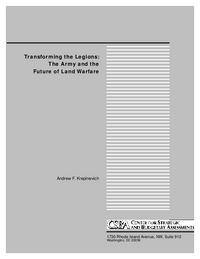
This study assesses the US Army’s transformation initiative. Its goal is principally diagnostic, rather than prescriptive. That is, this assessment examines the Army’s approach to transformation in light of the challenges it will likely confront over the mid- to long-term future (i.e., 2013–2018). It is not intended to be prescriptive (i.e., to offer an alternative to the Army’s transformation initiative). This assessment concludes that the Army’s transformation vision, if realized, would yield revolutionary results and displace the combined arms, mechanized operations that have dominated since the dawn of blitzkrieg. However, it also finds that there are substantial risks inherent in the Army’s approach to transformation, and that the Service is likely proceeding down a transformation path that is too narrow to account for the full range of missions it will likely confront in the post-transformation era.
The first question posed to those who advocate major changes in Army organization, doctrine and force structure is obvious: Why transform the world’s best army? Army transformation is the product of ongoing changes in the geopolitical and military-technical environment. They have created new challenges for the US military, and for the Army in particular. These challenges are:
- Projecting dominant land power against an anti-access/area-denial threat;
- Urban control and eviction operations;
- Stabilizing failed states, to include large failed states and failed states possessing nuclear weapons;
- Waging the war on terrorism; and
- Providing for defense of the US homeland.
These missions require a balanced force among four Army types:
The Territorial Army: This Army, concerned primarily with homeland defense, characterized the US Army during the early part of the nation’s history.
The Constabulary Army: This Army, concerned primarily with stability operations, has seen its role wax and wane throughout the nation’s history. The Constabulary Army experienced a dramatic decline following the Vietnam War, but the demand for its services increased following the Cold War’s end, and has jumped dramatically following the US-led invasions of Afghanistan and Iraq.
The Expeditionary Army: This is the Army that dominated during the world wars, when the United States projected the bulk of its ground combat power from the continental United States.Its role declined during the Cold War but has increased again with the shift in focus away from Europe and toward the “Arc of Instability” that stretches from the Middle East across South and Central Asia, through Southeast Asia up into Northeast Asia.
The Frontier Army: This forward-deployed Army dominated the Cold War era, but has declined with the withdrawal of substantial US forces from overseas following the Soviet Union’s collapse.
While today’s Army is primarily a legacy of the Frontier Army that manned the western alliance’s perimeter during the Cold War, there is clearly a need for an increase in Territorial, Constabulary and Expeditionary Army forces, with a corresponding decline in the Frontier Army. Given the Service’s current dominance in land warfare, the Army leadership could have taken an attitude of “If it isn’t broken, why fix it?” The fact that the Army has decided to remake itself before the emerging threats materialize speaks well for the institution. The Army is undertaking a transformation of its forces to better reflect the new conditions under which it must operate. However, the Service has focused the bulk of its efforts on enhancing an Expeditionary Army, while underemphasizing the Constabulary Army, and perhaps the Territorial Army as well.
The Army’s vision seizes upon opportunities made possible by rapidly advancing technologies, with particular emphasis on information-related technologies. The Army’s vision of “See first, understand first, act first and finish decisively” is truly transformational. This warfighting concept would eclipse the combined arms, mechanized, heavy forces that have dominated land warfare since the advent of blitzkrieg in favor of far more dispersed, yet highly networked, forces that fight the decisive battle not at close range but at extended ranges.
The Army’s transformation is designed to proceed along multiple force-structure paths. It plans to upgrade a portion of the Current (formerly Legacy) Force as a hedge against its transformation proceeding more slowly than anticipated, and to deal with near-term contingencies. The Army also is fielding an Interim (now referred to as Stryker) Force not only to support near-term requirements, but also to serve as a bridge to the fully transformed Objective, or Future Force.
The Army’s vision, while revolutionary, is also to a great extent circumstantial; that is to say, it is focused primarily on what might be termed the conventional, or “open” battle—engagements between regular, or conventional, forces in relatively unrestricted terrain. To this is added the ability to deploy forces from the Expeditionary Army very rapidly, in an anti-access/area-denial (A2/AD) threat environment. This is a desirable characteristic. By demonstrating that it is not only dominant in open battle against conventional forces in this era, but that it intends to maintain this dominance in the post-transformation era, the Army may dissuade enemies from creating ground forces to challenge the US military directly.
Moreover, by seeking to field a dominant ground force that can deploy and operate in an A2/AD environment, the Army is trying to ensure that the current US dominance in power-projection operations is sustained in a post-transformation conflict environment. Indeed, the Army, because of its potential ability to disperse its combat capability more widely than any of its sister Services, is potentially the force most capable of operating underneath an enemy’s A2/AD threat umbrella.



























